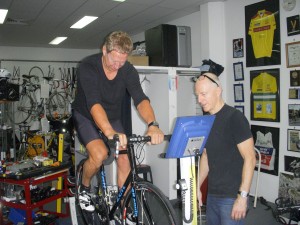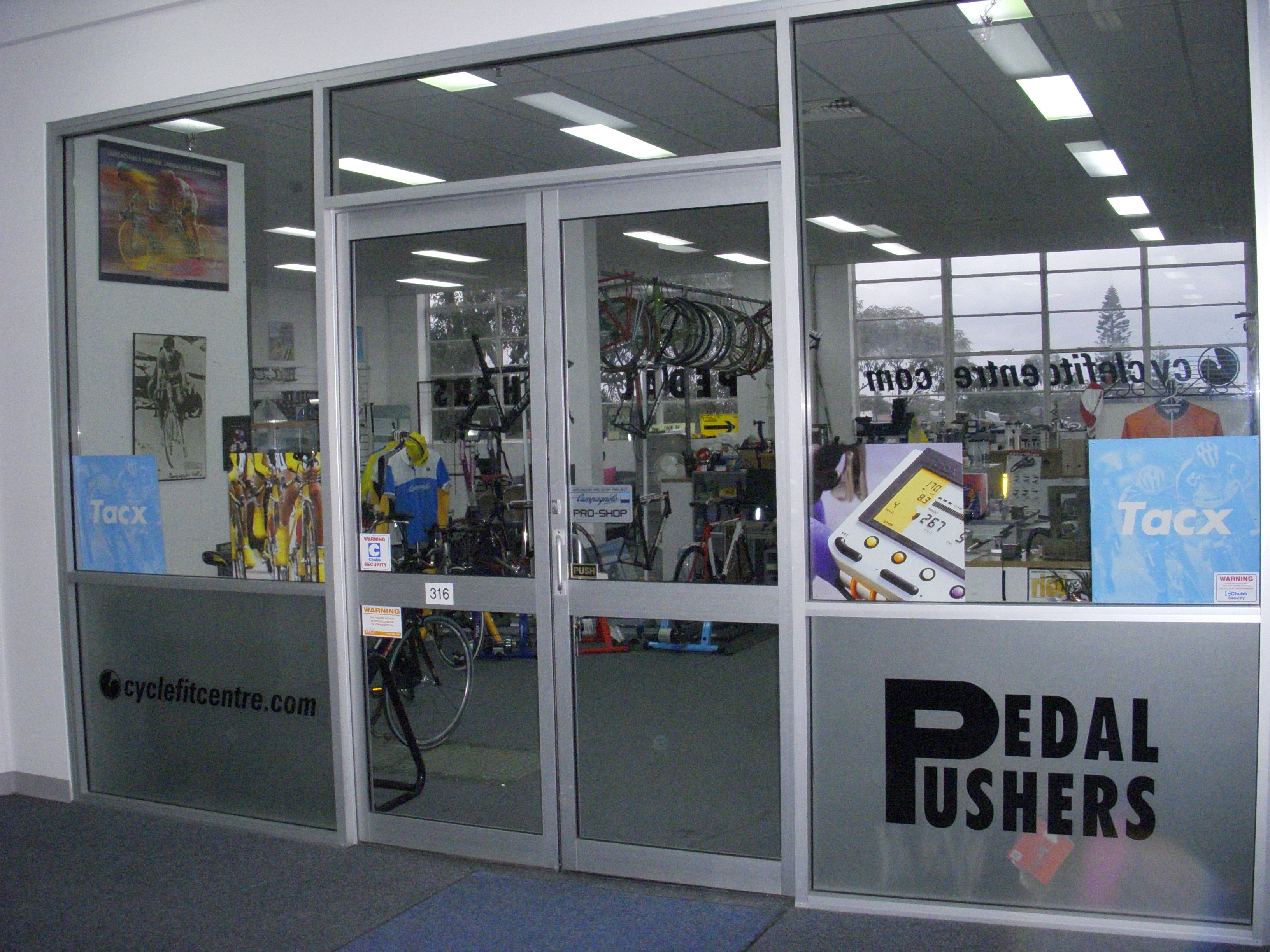Overview: What is Cyclefit?
Cyclefit is a process developed by Steve that is based on the idea that optimising neural function precedes biomechanics in importance. All systems of bike fitting, no matter how sophisticated they may appear are based on biometric (measurement based) or biomechanical models. Steve has patents granted that when applied, allow certainty in crucial areas of bike fitting, instead of the educated guesswork that is normally applied. The use of this IP and methodology is limited to ourselves, Scherrit Knoesen of The Bike Whisperer, Newbury, England; Colby Pearce of Pearce Coaching, Boulder, Colorado, U.S.A.; Jerry Gerlich of Castle Hill Fitness, Austin, Texas, U.S.A.; Toby Jones of BikeFit Asia,New Zealand; Neill Stanbury of Neill’s Bike Fit, Brisbane & Sunshine Coast, Australia; Aaron Dunford of Fusion Peak, Sydney, Australia; Tim Dejonghe of Bike Power, Belgium; Garry Kirk of Garry Kirk Bike Fitting, Scotland; Martin Ilagan of Forward Motion Performance, Philippines; Paul Chen of Paul Bike Fit, China; Andy Brooke of Andy Brooke Bike Fitting, Valencia, Spain; Tommy Nankervis of Bike Fit Melbourne, Melbourne, Australia; Josh Bilski of Bilski Bike Fitting, Canberra, Australia; Timothy Lim of Loue Bicycles, Singapore; and Arnusan “Jumm” Paojinda of Jumm’s Bike Studio, Thailand. See more details here.


To critique biometric and biomechanical models one at a time: Biometric systems fail because measuring a client’s limb lengths and body proportions is the static quantification of only one aspect of a person engaged in a dynamic activity (cycling) and doesn’t consider the enormous range of functional differences that can occur amongst people of similar size and proportions. Differences like degree of flexibility, functional stability, pedalling technique, functional and neurological asymmetries and so on. I hope there isn’t anyone who still seriously believes that measuring your torso length, arm and leg length and proportions and consulting standard tables for information equals a quality bike fit?
Biomechanical models are more complex and often use tooling like video or motion capture that have a “WOW!” factor. But, they miss the target in two crucial aspects. No. 1 is that neural function isn’t considered. Optimal biomechanical function depends on optimal neural function because every action on a bike starts with a signal from the brain or elsewhere in the central nervous system that is in the major part, based on a constant flow of proprioceptive feedback (see box) from the body. This process needs to be optimised within the functional constraints exhibited by the rider. Optimal neural function is intimately related to good posture and adequate flexibility.
No.2 is that no matter how high tech the tooling (motion or video capture), it is not the tooling that makes the decisions about fitting you to your bike; it is the judgement and expertise of the bike fitter. Video and motion capture systems are potentially quality aids for an inexperienced bike fitter. Too often though, the tooling becomes a technological “crutch” that the fitter never learns to “walk” without. That is that the fitter limits his or her informational assessment to what the tooling tells them, which is a tiny fraction of what a well trained and experienced human eye can discern. What you are paying for is expertise, not tooling.
A bicycle is a symmetrical apparatus in a positional sense but humans all function with varying degrees of asymmetry. So, it is important that a good position allows the rider to be as functionally symmetrical as their current structural make up allows. Any challenge to the rider’s position from any source, whether it is from poor position, inflexibility or lack of proprioceptive awareness from the parts of the body involved in generating force, or issues with spatial awareness related to vision or the vestibular system, will cause the rider to develop a pattern of compensation. All patterns of compensation work by increasing the tendency to asymmetry. So a quality bike fit is mainly concerned with establishing a functionally symmetrical position by identifying and removing as many challenges to the rider’s position as possible. In addition, principles of fitting that Steve has evolved are applied. The nature of these fitting principles means that the detail of their individual application varies as much as people do.
Steve registered the name Cyclefit in Australia in September ’96. Since then a number of businesses in the U.K., Germany, Belgium , U.S. and New Zealand have taken to using the same or a similar name. We have no connection, past or present, with any of these businesses. There are a number of people who imply a connection with Steve or who claim to use “Steve Hogg methods.” Steve has no connection past or present with any of these people. The only people that Steve has authorised to say so and are licensed to use patented IP developed by Steve are:
- Scherrit Knoesen of The Bike Whisperer in Newbury, England. Scherrit can be contacted via: enquiries@thebikewhisperer.co.uk
- Colby Pearce of Pearce Coaching, Boulder, Colorado, U.S.A. Colby can be contacted via: colbypearce@mac.com
- Jerry Gerlich of Castle Hill Fitness, Austin, Texas, U.S.A. Jerry can be contacted via: jerrybikefit@gmail.com
- Toby Jones of BikeFit Asia, New Zealand. Toby can be contacted via: toby@bikefitasia.com
- Neill Stanbury of Neill’s Bike Fit, Brisbane & Sunshine Coast, Austrailia. Neill can be contacted via: neillsbikefit@gmail.com
- Aaron Dunford of Fusion Peak, Sydney, Australia. Aaron can be contacted via: aaron@fusionpeak.com.au
- Tim Dejonghe of Bike Power, Belgium. Tim can be contacted via: bikefitting@bikepower.be
- Garry Kirk of Garry Kirk Bike Fitting, Scotland. Garry can be contacted via: info@garrykirkbikefitting.com
- Martin Ilagan of Forward Motion Performance, Phillippines. Martin can be contacted via: vicemilagan@yahoo.com.ph
- Paul Chen of Paul Bike Fit, China. Paul can be contacted via: paulbicycle@foxmail.com
- Andy Brooke of Andy Brooke Bike Fitting, Valencia, Spain. Andy can be contacted via: andrew.brooke@gmail.com
- Tommy Nankervis of Bike Fit Melbourne, Melbourne, Australia. Tommy can be contacted via: tommy@tineli.com.au
- Josh Bilski of Bilski Bike Fitting, Canberra, Australia. Josh can be contacted via: bilski.bikefitting@gmail.com
- Timothy Lim of Loue Bicycles, Singapore. Timothy can be contacted via: tim@louebicycles.com
- Arnusan “Jumm” Paojinda of Jumm’s Bike Studio, Thailand. Jumm can be contacted via: arnusan@gmail.com
What makes Steve’s approach different to others?
Firstly, Steve is not interested in applying formulaic methods; that is fitting a client into a predetermined “box.” He is interested in identifying, removing or minimising any challenges to a client’s position on their bike. A challenge is any factor that decreases a rider’s stability or increases the tendency to asymmetry on a bike. Challenges fall into three major categories: Positional, Functional and Neurological. There is also a sub category of Neurological Challenge that Steve has named Material Challenges where the material make up of some cycling accessories and equipment is antithetical to proprioceptive clarity.
Secondly, Steve’s approach is all about maximising proprioceptive clarity from the feet. This is a major but little known factor in rider positioning that Steve has identified and found the solution to. For more about this, click here.
Remember: COMFORT+EFFICIENCY=PERFORMANCE
(Choose your Cyclefit option here.)



